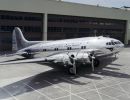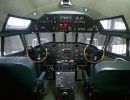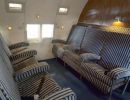



The 307 made its public debut at EAA AirVenture 2001 after an extensive six-year restoration project. In March 2002, just before it was to be delivered for enshrinement in the National Air and Space Museum in Washington D.C., the airplane was forced to ditch over Elliott Bay, just west of downtown Seattle, Washington, when it ran out of fuel during a routine practice flight.
When Boeing engineers found only secondary structural damage to the airplane, the company dedicated about 70 people - a combination of full-time employees and volunteers - to repair the aircraft over the past year and restore its airworthiness. About 30 retired Boeing employees did the original restoration in Seattle guided by original drawings from company archives.
They retained its original nickname, The Clipper Flying Cloud provided by Pan American Airways which took delivery of the aircraft in 1940. The Stratoliner will eventually be on display at the new Steven F. Udvar-Hazy Center, the new companion facility of the Smithsonian's National Air and Space Museum scheduled to open at Washington (D.C.) Dulles International Airport in December 2003.
The 307 was revolutionary in that it allowed flight above the weather at altitudes up to 20,000 feet. It also was the first four-engine airliner in scheduled domestic service. It carried five crew members, including the first flight engineer for a land-based airplane, and 33 passengers. The nearly 12-ft. wide cabin had space for overnight berths.
The airplane was "discovered" by several Boeing employees while visiting the Pima Air Museum in Tucson, Arizona. They learned it was the last Stratoliner in existence.
Five Stratoliners were produced for Transcontinental and Western Air, which later became Trans World Airlines; three for Pan Am; and one for multimillionaire Howard Hughes. Hughes purchased the airplane for $250,000 and turned it into the first luxury private airliner.
TWA introduced the aircraft into service in 1940 with a 12-hour, 18-minute flight from New York to Los Angeles. TWA's routes also included Chicago, Kansas City, Missouri, and Albuquerque, New Mexico. Pan Am flew from Miami, New Orleans and Brownsville, Texas, into Mexico City and Central and South America.
Sixteen months after the introduction of the Stratoliner, World War II broke out and Boeing quickly focused on building the B-17 Flying Fortress, which shares the same wing and tail design as the 307.
July 16, 2003
MORE (Vintage Boeing)
EAA Aviation Center



All pictures are the property of EAA